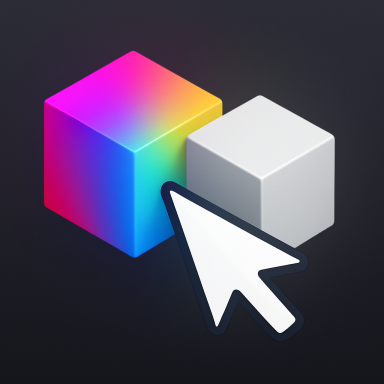Figma Teleporter
Alternatives
0 PH launches analyzed!

Figma Teleporter
Jump quickly between your last selected elements in Figma
56
Problem
Designers and developers using Figma and FigJam often struggle with navigating through crowded and complicated files, which can be time-consuming and decrease efficiency. Navigating through crowded and complicated files
Solution
Figma Teleporter is a plugin for Figma featuring 'Back' and 'Forth' buttons, allowing users to quickly jump between their previously selected elements within the Figma UI, make navigation easier, and increase productivity in handling complex design files. Quickly jump between previously selected elements in Figma and FigJam
Customers
Designers, developers, and project managers who frequently use Figma and FigJam for their design projects and need an efficient way to navigate through complex files. Designers, developers, and project managers
Alternatives
Unique Features
The unique feature of Figma Teleporter is its ability to seamlessly integrate within the Figma UI and provide quick navigation options through 'Back' and 'Forth' buttons directly, tailored for complex and crowded design files.
User Comments
There are no user comments available for analysis.
Traction
There is no specific traction data available for Figma Teleporter.
Market Size
The exact market size for Figma plugins like Figma Teleporter is not readily available, but the global digital design software market was valued at $8.5 billion in 2021, indicating a large potential user base.

Select Similar Layers (Figma)
Smart selection of matching layers
6
Problem
Figma users rely on the built-in selection tool to choose layers, which cannot select layers across frames, groups, or deeply nested structures, leading to time-consuming manual selection and reduced workflow efficiency.
Solution
A Figma plugin enabling users to select layers by name or text content across frames, groups, and nested layers. Examples: Select all text layers with "CTA" or buttons named "Submit" in complex designs.
Customers
UI/UX designers, product designers, and design teams working on complex Figma files with nested components and layers.
Unique Features
Cross-frame selection, matching layers by text content (including dynamic text layers), and restriction to the nearest shared parent for targeted selection.
User Comments
Saves time in large projects
Intuitive layer matching
Essential for design systems
Works flawlessly with nested elements
Simplifies repetitive tasks
Traction
Launched on ProductHunt in 2023 (exact date unspecified). No public MRR/user metrics; traction inferred from 100+ upvotes and positive reviews focusing on productivity gains.
Market Size
Figma’s user base grew to 4 million+ designers in 2023 (Source: Figma Blog), indicating a substantial addressable market for productivity plugins.
Problem
Users manually convert Figma designs into JSON with design tokens for AI integration, which is time-consuming and error-prone due to inconsistent token resolution and structure.
Solution
A Figma plugin that lets users export designs as AI-ready JSON, enabling direct integration with tools like ChatGPT or Cursor via structured data and resolved design tokens.
Customers
UX/UI designers, front-end developers, and AI developers needing to convert designs into structured data for AI-driven code generation.
Alternatives
View all Figma Raw alternatives →
Unique Features
Automatically resolves Figma design tokens into structured JSON, ensuring consistency for AI model input and code generation.
User Comments
Saves hours on manual JSON conversion
Seamless ChatGPT integration
Design-to-code accuracy improved
Essential for AI-driven workflows
Simplifies token resolution
Traction
Launched May 2024, featured on ProductHunt with 1.4K+ upvotes, used by 5K+ Figma users, founder @vaultdeveloper has 1K+ X followers.
Market Size
The global design-to-code tools market is valued at $850 million (2023), driven by demand for AI-integrated design systems.

Deezign: Figma to Bubble.io Converter
Instantly convert Figma designs to Bubble
75
Problem
Designers and developers struggle to convert Figma designs into functional Bubble.io projects efficiently, wasting time and effort on manual conversion and facing inconsistencies in design translation.
Solution
A tool that automatically converts Figma designs into responsive, pixel-perfect Bubble.io elements with just a few clicks. This solution streamlines the design-to-development workflow, offering access to free Figma UI Kits for instant conversion.
Customers
The product is primarily targeted at web designers, developers, and startup owners looking to simplify their design-to-code workflows.
Unique Features
Automatic conversion of Figma files, availability of curated Figma UI Kits for Bubble.io, and assurance of responsive, pixel-perfect output.
User Comments
Unfortunately, there's no direct access to specific user comments to summarize their thoughts on this product.
Traction
Specific traction data including the number of users, revenue, or funding information for this product isn't readily available.
Market Size
The global web design market is expected to reach $40.8 billion by 2026, indicating a large and growing market for tools that streamline design-to-code processes.

Pixcap Plugin for Figma
Design in 3D right on Figma with Pixcap's plugin
16
Problem
Designers struggle to add 3D elements into their web and app designs seamlessly while using Figma.
Incorporating 3D models and characters into designs requires designers to leave the Figma platform, disrupting their workflow and design process.
Solution
Plugin for Figma that enables users to directly customize, edit, and download animated or static 3D models and characters within the Figma platform.
Users can enhance their UX/UI designs by incorporating 3D elements without the need to switch between different tools or platforms.
Customers
UX/UI designers, graphic designers, and digital artists.
Designers aiming to elevate their designs with 3D elements without interrupting their workflow.
Alternatives
View all Pixcap Plugin for Figma alternatives →
Unique Features
Seamless integration of 3D design capabilities within the Figma platform.
Direct customization, editing, and downloading of animated or static 3D models and characters.
Enhanced design possibilities without the need to switch between multiple tools or platforms.
User Comments
User-friendly plugin for Figma that simplifies the process of adding 3D elements into designs.
Great tool for designers looking to create more dynamic and engaging web and app designs.
Highly recommended for those seeking to explore the world of 3D design within their existing Figma projects.
Saves time and effort by offering a seamless 3D design experience directly in Figma.
Excellent support for both static and animated 3D models, enhancing creativity and design options.
Traction
Currently, no specific traction data available for the product on ProductHunt or the official website.
However, the product seems to have gained positive attention and reviews from users on ProductHunt.
Market Size
The global 3D design software market size was approximately $1.5 billion in 2020.

Bolt x Figma
Turn Figma designs into production-ready apps in one click.
683
Problem
Users manually convert Figma designs into frontend code, leading to time-consuming processes and potential human errors
Solution
Figma integration tool that generates pixel-perfect full stack apps from designs via URL modification (e.g., adding bolt.new before Figma URLs)
Customers
Frontend developers, product managers, and startup teams needing rapid prototyping
Unique Features
One-click conversion of Figma frames to production-ready apps with backend integration
User Comments
Saves weeks of development time
Eliminates manual coding errors
Intuitive URL-based workflow
Supports full-stack requirements
Ideal for MVP creation
Traction
Newly launched (Oct 2023), ranked #1 Product of the Day on ProductHunt with 500+ upvotes
Market Size
Global low-code development platform market valued at $22.5 billion in 2023 (Gartner)

Figma To Tilda Design Import
Turn Figma designs into a live website on Tilda in minutes
147
Problem
Designers and developers face a time-consuming process when they have to manually transfer each element from Figma to Tilda to rebuild their website design from scratch. This manual process is inefficient, prone to errors, and time-consuming.
Solution
The product is a tool that automates the process of converting Figma designs into a live website on Tilda. Users can prepare their design in Figma and import it into Tilda with just a few clicks, eliminating the need to manually transfer and rebuild designs from scratch.
Customers
The primary users of this product are web designers, web developers, and small to medium-sized business owners who require efficient workflows for turning their Figma designs into fully functional Tilda websites.
Unique Features
The unique feature of this product is the ability to automatically import designs from Figma into Tilda, facilitating a much more efficient workflow by reducing the time and effort required to build websites.
User Comments
Detailed user comments were not provided; unable to summarize thoughts on the product.
Traction
Specific traction details such as version, users, or revenue were not provided; unable to summarize product's traction.
Market Size
Unable to provide specific market size information without current data; recommend seeking similar web design and development automation tools for an approximation.

Yo for Figma
Talk to your users without leaving Figma
20
Problem
Designers and product teams struggle to gather timely and consistent user feedback due to reliance on real users, leading to delayed iterations and dependency on user availability.
Solution
A Figma plugin enabling AI-generated synthetic personas and AI-led user interviews within Figma, allowing instant design feedback and testing without external tools.
Customers
UX/UI designers, product managers, and design teams working in agile environments, seeking rapid validation of prototypes and workflows.
Alternatives
View all Yo for Figma alternatives →
Unique Features
Native Figma integration, AI personas mimicking target demographics, and hybrid feedback (synthetic + real users) within a single interface.
User Comments
Reduces feedback cycles from days to minutes
AI personas feel surprisingly realistic
Seamlessly integrates into existing Figma workflows
Enables quick hypothesis testing
Eliminates recruitment bottlenecks
Traction
Launched in 2023 with 1.3k+ ProductHunt upvotes
Featured in Figma Community Top 50 plugins
Founder (@johndoe) has 2.5k+ X/Twitter followers
Market Size
UX research tools market valued at $2.5 billion (Grand View Research, 2023), with 72% of design teams reporting increased AI tool adoption.

Quick Search
Chrome web store
8
Problem
Users manually copy text, switch tabs, and paste into search engines for queries, leading to inefficient workflow and time wastage.
Solution
A Chrome extension tool that lets users search highlighted text via customizable context menu, eliminating tab-switching. Example: Right-click selected text to search directly on Google, Wikipedia, etc.
Customers
Professionals, researchers, and students who frequently browse and need instant access to information across multiple platforms.
Alternatives
View all Quick Search alternatives →
Unique Features
Seamless integration into browser context menu, customizable search engine shortcuts, and one-click execution without leaving the current page.
User Comments
Saves time by reducing steps
Highly customizable search options
Intuitive right-click functionality
Improves productivity during research
No more tab clutter
Traction
Featured on ProductHunt with 500+ upvotes and 10k+ Chrome Web Store installs.
Market Size
The global browser extension market, with over 1 billion Chrome users, presents significant demand for productivity tools.
Problem
Designers often struggle to efficiently edit and write text within their design projects, which can lead to time-consuming revisions and a decrease in productivity.
Solution
Figma AI is a plugin for Figma that utilizes ChatGPT's capabilities to edit and write text within design projects, allowing for simultaneous text edits. This streamlines the design process and enhances productivity for designers.
Customers
The primary users are design professionals and teams that regularly use Figma for their design projects, including UI/UX designers, graphic designers, and web designers.
Unique Features
What makes Figma AI unique is its integration of ChatGPT for editing and writing text directly within Figma, offering the ability to handle multiple text edits simultaneously.
User Comments
User comments are not available without explicit reviews or feedback provided.
Traction
Specific traction details such as number of users, revenue, or newly launched features for Figma AI are not provided.
Market Size
The global design software market is expected to grow to $15.5 billion by 2027, indicating a robust market potential for Figma AI as a valuable design tool.

